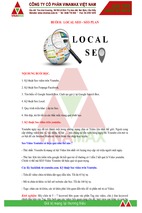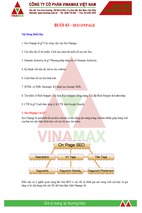Ch 7 Bankruptcy Cvr
2/8/07
10:18 AM
Page 1
Past-due notices, harassing phone calls and court actions can all be stopped, and
The Complete Chapter 7 Personal Bankruptcy Guide will show you
how. It gives you exactly what you need to stop living day-to-day and regain control
of your finances once and for all. The plain-English instructions it provides will guide
you through filing your own bankruptcy and finding that fresh start you deserve.
Protect your Future
Start Building Good Credit
Put your financial future back on
track by ending garnishments and
attachments, and protecting your
retirement money.
Get on the road to financial freedom by
raising your credit score, changing bad
habits and managing your resources
more effectively.
Cease Collection Agency
Harassment
Stop Repossessions and
Lawsuits
Use the bankruptcy law’s automatic
stay provision to get creditors off your
back.
Keep your car and other personal
property by using exemptions you are
entitled to take.
Quiet Creditor Calls
Protect Your Home and Family
Stop annoying phone calls and
prevent future harassment.
Save your home from foreclosure or stop
an eviction from putting your family out
on the street.
HAVE ALL YOUR DEBTS FORGIVEN
TO TRULY START FRESH
®
Personal Finance
$18.95 U.S.
ISBN-13: 978-1-57248-594-5
ISBN-10: 1-57248-594-9
w w w. S p h i n x L e ga l . c o m
$24.95 CAN
£9.99 UK
EAN
SPHINX PUBLISHING
AN IMPRINT OF SOURCEBOOKS, INC.®
NAPERVILLE, ILLINOIS
UPC
ISBN-13: 978-1-57248-573-0
ISBN-10: 1-57248-573-6
Ask Your Bookseller
About This
Other Bestselling Title
THE
Ready-to-Go forms with
step-by-step instructions
COMPLETE CHAPTER 7 PERSONAL BANKRUPTCY GUIDE
YOUR EASY-TO-FOLLOW ACTION PLAN
FOR FINANCIAL RECOVERY
EVERYTHING You
Need to Use the
New Bankruptcy
Laws to Your
Advantage
The
Complete
Chapter 7
Personal
Bankruptcy
Guide
➤ Exemptions
➤ State-by-State Laws
➤ Alternatives
➤ Checklists
➤ Federal Guidelines
➤ Worksheets
HAMAN
E D WA R D
A.
ATTORNEY
HAMAN
AT
L AW
Ch7 Bnkrptcy FM.qxp
1/31/07
5:12 PM
Page i
The Complete
Chapter 7
Personal
Bankruptcy
Guide
Ch7 Bnkrptcy FM.qxp
1/31/07
5:12 PM
Page ii
Ch7 Bnkrptcy FM.qxp
1/31/07
5:12 PM
Page iii
The Complete
Chapter 7
Personal
Bankruptcy
Guide
Edward A. Haman
Attorney at Law
SPHINX PUBLISHING
®
AN IMPRINT OF SOURCEBOOKS, INC.®
NAPERVILLE, ILLINOIS
www.SphinxLegal.com
Ch7 Bnkrptcy FM.qxp
1/31/07
5:12 PM
Page iv
Copyright © 2007 by Edward A. Haman
Cover and internal design © 2007 by Sourcebooks, Inc.®
All rights reserved. No part of this book may be reproduced in any form or by any electronic or mechanical
means including information storage and retrieval systems—except in the case of brief quotations embodied in critical articles or reviews—without permission in writing from its publisher, Sourcebooks, Inc.
Purchasers of the book are granted license to use the forms contained herein for their own personal use. No
claim of copyright is made to any government form reproduced herein. All brand names and product names
used in this book are trademarks, registered trademarks, or trade names of their respective holders.
Sourcebooks and the colophon are registered trademarks of Sourcebooks, Inc.
First Edition: 2007
Published by: Sphinx® Publishing, An Imprint of Sourcebooks, Inc.®
Naperville Office
P.O. Box 4410
Naperville, Illinois 60567-4410
630-961-3900
Fax: 630-961-2168
www.sourcebooks.com
www.SphinxLegal.com
This publication is designed to provide accurate and authoritative information in regard to the subject matter covered. It is sold with
the understanding that the publisher is not engaged in rendering legal, accounting, or other professional service. If legal advice or
other expert assistance is required, the services of a competent professional person should be sought.
From a Declaration of Principles Jointly Adopted by a Committee of the
American Bar Association and a Committee of Publishers and Associations
This product is not a substitute for legal advice.
Disclaimer required by Texas statutes.
Library of Congress Cataloging-in-Publication Data
Haman, Edward A.
The complete Chapter 7 personal bankruptcy guide / by Edward A. Haman. -1st ed.
p. cm.
Includes index.
ISBN-13: 978-1-57248-717-8
ISBN-10: 1-57248-717-8
1. Bankruptcy--United States--Popular works. I. Title.
KF1524.6.H35 2007
346.7307'8--dc22
2007000856
Printed and bound in the United States of America.
SB — 10 9 8 7 6 5 4 3 2 1
1/31/07
5:12 PM
Page v
Contents
chapter
Ch7 Bnkrptcy FM.qxp
Using Self-Help Law Books . . . . . . . . . . . . . . . . . . . . . . ix
Introduction. . . . . . . . . . . . . . . . . . . . . . . . . . . . . . . . . . xiii
Section 1: Bankruptcy and
the Legal System . . . . . . . . . . . . . . . . . . . . . . 1
History and General Information
The Legal System
Bankruptcy Law and Procedure
Section 2: Lawyers . . . . . . . . . . . . . . . . . . . . . . . . . . . . . 13
Needing a Lawyer
Selecting a Lawyer
Working with a Lawyer
Firing Your Lawyer
Section 3: Avoiding Bankruptcy . . . . . . . . . . . . . . . . . 21
The Effects of Bankruptcy
Income and Expenses Worksheet
Property Worksheet
Ch7 Bnkrptcy FM.qxp
1/31/07
5:12 PM
Page vi
the complete chapter 7 personal bankruptcy guide
vi
Debt Assessment
General Guidelines
Alternatives to Bankruptcy
Section 4: Preparing for Bankruptcy . . . . . . . . . . . . . 43
Basic Legal Requirements
Arranging Your Finances
Section 5: Gathering Information . . . . . . . . . . . . . . . . 49
Income
Expenses
Property
Debts
Legal Research
Section 6: Forms and Procedures . . . . . . . . . . . . . . . . 57
Qualifying for Chapter 7 Bankruptcy
Understanding Legal Forms
Voluntary Petition
Application to Pay Filing Fee in Installments
Application for Waiver of the Chapter 7 Filing Fee
Schedule A—Real Property
Schedule B—Personal Property
Schedule C—Property Claimed as Exempt
Schedule D—Creditors Holding Secured Claims
Schedule E—Creditors Holding Unsecured Priority Claims
Schedule F—Creditors Holding Unsecured Nonpriority Claims
Schedule G—Executory Contracts and Unexpired Leases
Schedule H—Codebtors
Schedule I—Current Income of Individual Debtor(s)
Schedule J—Current Expenditures of Individual Debtor(s)
Summary of Schedules
Declaration Concerning Debtor’s Schedules
Statement of Financial Affairs
Chapter 7 Individual Debtor’s Statement of Intention
Chapter 7 Statement of Current Monthly Income and MeansTest Calculation
Debtor’s Certification of Completion of Instructional Course
Concerning Personal Financial Management
Ch7 Bnkrptcy FM.qxp
1/31/07
5:12 PM
Page vii
contents
vii
Master Address Lists and Mailing Matrix
Filing with the Court Clerk and Notifying Creditors
Creditors’ Meeting
Court Hearing and Discharge
Section 7: Special Circumstances . . . . . . . . . . . . . . . . 97
Amending Your Paperwork
Changing from Chapter 13 to Chapter 7
Lien Avoidance
Redemption
Reaffirming a Debt
Lawsuits
Pensions and Retirement Plans
Section 8: After Your Discharge. . . . . . . . . . . . . . . . . 103
Handling Your Finances
Obtaining Credit
Glossary . . . . . . . . . . . . . . . . . . . . . . . . . . . . . . . . . . . . . 107
Appendix A: Exemptions
(Federal and State) . . . . . . . . . . . . . . . . 111
Appendix B: Checklist and Worksheets . . . . . . . . . . 169
Appendix C: Blank Forms . . . . . . . . . . . . . . . . . . . . . . 175
Index . . . . . . . . . . . . . . . . . . . . . . . . . . . . . . . . . . . . . . . . 249
About the Author . . . . . . . . . . . . . . . . . . . . . . . . . . . . . 255
Ch7 Bnkrptcy FM.qxp
1/31/07
5:12 PM
Page viii
Ch7 Bnkrptcy FM.qxp
1/31/07
5:12 PM
Page ix
Using Self-Help
Law Books
Before using a self-help law book, you should realize the advantages
and disadvantages of doing your own legal work and understand the
challenges and diligence that this requires.
The Growing
Trend
Rest assured that you will not be the first or only person handling
your own legal matter. For example, in some states, more than 75% of
the people in divorces and other cases represent themselves. Because
of the high cost of legal services, this is a major trend, and many
courts are struggling to make it easier for people to represent themselves. However, some courts are not happy with people who do not
use attorneys and refuse to help them in any way. For some, the attitude is, “Go to the law library and figure it out for yourself.”
We write and publish self-help law books to give people an alternative
to the often complicated and confusing legal books found in most law
libraries. We have made the explanations of the law as simple and
easy to understand as possible. Of course, unlike an attorney advising an individual client, we cannot cover every conceivable possibility.
Ch7 Bnkrptcy FM.qxp
1/31/07
5:12 PM
Page x
the complete chapter 7 personal bankruptcy guide
Cost/Value
Analysis
x
Whenever you shop for a product or service, you are faced with various levels of quality and price. In deciding what product or service to
buy, you make a cost/value analysis on the basis of your willingness
to pay and the quality you desire.
When buying a car, you decide whether you want transportation, comfort, status, or sex appeal. Accordingly, you decide among choices such
as a Neon, a Lincoln, a Rolls Royce, or a Porsche. Before making a
decision, you usually weigh the merits of each option against the cost.
When you get a headache, you can take a pain reliever (such as
aspirin) or visit a medical specialist for a neurological examination.
Given this choice, most people, of course, take a pain reliever, since it
costs only pennies; whereas a medical examination costs hundreds of
dollars and takes a lot of time. This is usually a logical choice because
it is rare to need anything more than a pain reliever for a headache.
But in some cases, a headache may indicate a brain tumor, and failing to see a specialist right away can result in complications. Should
everyone with a headache go to a specialist? Of course not, but people
treating their own illnesses must realize that they are betting, on the
basis of their cost/value analysis of the situation, that they are taking
the most logical option.
The same cost/value analysis must be made when deciding to do one’s
own legal work. Many legal situations are very straightforward,
requiring a simple form and no complicated analysis. Anyone with a
little intelligence and a book of instructions can handle the matter
without outside help.
But there is always the chance that complications are involved that
only an attorney would notice. To simplify the law into a book like
this, several legal cases often must be condensed into a single sentence or paragraph. Otherwise, the book would be several hundred
pages long and too complicated for most people. However, this simplification necessarily leaves out many details and nuances that would
apply to special or unusual situations. Also, there are many ways to
interpret most legal questions. Your case may come before a judge
who disagrees with the analysis of our authors.
Ch7 Bnkrptcy FM.qxp
1/31/07
5:12 PM
Page xi
using self-help law books
xi
Therefore, in deciding to use a self-help law book and to do your own
legal work, you must realize that you are making a cost/value analysis. You have decided that the money you will save in doing it yourself
outweighs the chance that your case will not turn out to your satisfaction. Most people handling their own simple legal matters never
have a problem, but occasionally people find that it ended up costing
them more to have an attorney straighten out the situation than it
would have if they had hired an attorney in the beginning. Keep this
in mind while handling your case, and be sure to consult an attorney
if you feel you might need further guidance.
Local Rules
The next thing to remember is that a book which covers the law for
the entire nation, or even for an entire state, cannot possibly include
every procedural difference of every jurisdiction. Whenever possible,
we provide the exact form needed; however, in some areas, each
county, or even each judge, may require unique forms and procedures.
In our state books, our forms usually cover the majority of counties in
the state or provide examples of the type of form that will be required.
In our national books, our forms are sometimes even more general in
nature but are designed to give a good idea of the type of form that
will be needed in most locations. Nonetheless, keep in mind that your
state, county, or judge may have a requirement, or use a form, that is
not included in this book.
You should not necessarily expect to be able to get all of the information and resources you need solely from within the pages of this book.
This book will serve as your guide, giving you specific information
whenever possible and helping you to find out what else you will need
to know. This is just like if you decided to build your own backyard
deck. You might purchase a book on how to build decks. However, such
a book would not include the building codes and permit requirements
of every city, town, county, and township in the nation; nor would it
include the lumber, nails, saws, hammers, and other materials and
tools you would need to actually build the deck. You would use the
book as your guide, and then do some work and research involving
such matters as whether you need a permit of some kind, what type
and grade of wood is available in your area, whether to use hand tools
or power tools, and how to use those tools.
Ch7 Bnkrptcy FM.qxp
1/31/07
5:12 PM
Page xii
the complete chapter 7 personal bankruptcy guide
xii
Before using the forms in a book like this, you should check with your
court clerk to see if there are any local rules of which you should be
aware or local forms you will need to use. Often, such forms will
require the same information as the forms in the book but are merely
laid out differently or use slightly different language. They will sometimes require additional information.
Besides being subject to local rules and practices, the law is subject to
change at any time. The courts and the legislatures of all fifty states
are constantly revising the laws. It is possible that while you are
reading this book, some aspect of the law is being changed.
In most cases, the change will be of minimal significance. A form will
be redesigned, additional information will be required, or a waiting
period will be extended. As a result, you might need to revise a form,
file an extra form, or wait out a longer time period. These types of
changes will not usually affect the outcome of your case. On the other
hand, sometimes a major part of the law is changed, the entire law in
a particular area is rewritten, or a case that was the basis of a central legal point is overruled. In such instances, your entire ability to
pursue your case may be impaired.
Ch7 Bnkrptcy FM.qxp
1/31/07
5:12 PM
Page xiii
Introduction
If you are like most Americans, you are probably struggling to make
payments on a mortgage, car loans, medical bills, various credit cards,
student loans, home improvement loans, or other kinds of debt.
Perhaps you have been laid off at work due to local or nationwide economic conditions, or due to problems with your company or industry.
Maybe you or a member of your family had a serious illness or injury,
and many of the medical bills were not covered by insurance.
This book is designed specifically for you. It will help you analyze
your situation, decide whether you should file for bankruptcy, and
guide you through the steps to either avoid bankruptcy or get through
the bankruptcy procedure. This is not a law school course, but a practical guide to get you through the system as easily as possible.
This book presents fairly simplified procedures for use by non-attorneys. It does not contain all the possible loopholes or tricks of the
trade that an experienced bankruptcy lawyer might use to gain a little
extra advantage. On the other hand, for many people, these legal
details either do not apply or their advantage will be offset by having
to pay the fee of an experienced bankruptcy attorney.
Ch7 Bnkrptcy FM.qxp
1/31/07
5:12 PM
Page xiv
the complete chapter 7 personal bankruptcy guide
xiv
If you are at a high income level, or have extensive and complicated
investments and debts, you will need a lawyer. However, this book
will still help you understand the system and work with your lawyer
more effectively.
NOTE: This book is not designed for corporate, partnership, or businessrelated bankruptcies.
Bankruptcy law is covered in various chapters of the federal
Bankruptcy Code. This book covers bankruptcy under Chapter 7 of
the Bankruptcy Code. In order to avoid confusion between chapters of
the Bankruptcy Code and what would normally be called chapters of
this book, the word “section” is used instead of the word “chapter”
when referring to this book. The word “chapter” is only used when
referring to the Bankruptcy Code.
Sections 1 through 5 of this book explain the legal system, help you
decide if bankruptcy is for you, and assist your preparation for filing
for bankruptcy. Section 6 explains the details of pursuing a case
under Chapter 7 of the Bankruptcy Code. Section 7 deals with special
circumstances that may arise, and Section 8 gives you some advice for
the future—after you have completed your bankruptcy case in court.
Appendix A contains the federal and state lists of property that you
may keep even if you file for bankruptcy. Appendix B provides some
checklists for filing bankruptcy and worksheets that will help you fill
in the forms in Appendix C.
Be sure to read this entire book, especially the parts of Section 6 on
“Understanding Legal Forms,” before you begin preparing any of the
forms in this book. You may want to make several copies of the forms
in this book and save the originals, so you can make more copies if you
need them.
1/31/07
5:12 PM
Page 1
Bankruptcy and
the Legal System
This section gives you a basic overview of bankruptcy law and the
legal system. It includes vital information about legal terminology,
bankruptcy court procedures, the types of bankruptcy relief available,
and the recent changes in the bankruptcy law. Do not skip this section,
as it provides you with basic information you need in order to fully
understand the later sections.
HISTORY AND GENERAL INFORMATION
Simply stated, bankruptcy is a legal procedure that allows you to
get out of oppressive debt and get a fresh start financially. The concept
of bankruptcy goes back at least to the time of the Old Testament,
which states:
At the end of every seven years you shall grant a release and
this is the manner of the release: every creditor shall release
what he has lent to his neighbor….
—(Deuteronomy 15:1-2)
In the United States, the importance of bankruptcy was recognized at
the time of our nation’s birth and was made a part of the U.S.
section 1
Ch7 Bnkrptcy Body.qxp
Ch7 Bnkrptcy Body.qxp
1/31/07
5:12 PM
Page 2
the complete chapter 7 personal bankruptcy guide
2
Constitution. Article I, Section 8 of the U.S. Constitution gives
Congress the power to establish “uniform laws on the subject of bankruptcies throughout the United States.” In 1800, Congress enacted
the first bankruptcy laws.
Today, there exists a comprehensive set of federal laws that govern
bankruptcy. There are so many bankruptcies filed each year that
there is a special division of the federal court system devoted exclusively to bankruptcy. In recent years, personal bankruptcy filings
have reached over one million annually. If you need to file for bankruptcy, you can be sure you will not be alone.
Recent
Changes in
Bankruptcy
Law
The average person filing for bankruptcy has an annual income of
about $22,000, and has probably undergone a substantial period of
unemployment. Many are single mothers. One study indicates that
about half of all bankruptcies are the result of large, uninsured medical expenses.
In spite of this, creditors (mostly credit card companies) have convinced Congress that far too many people filing for bankruptcy are
simply irresponsible consumers out to run up large debts that they
avoid paying through bankruptcy. This resulted in Congress passing
the Bankruptcy Abuse Prevention and Consumer Protection Act of
2005 (commonly abbreviated BAPCPA). This new law consists of over
500 pages, which can be summed up by saying that it is now more difficult for people to wipe out debts through bankruptcy. The changes to
the law are incorporated in the information and forms contained in
this book.
Purpose and
Procedure
The bankruptcy procedure serves two purposes. First, it allows you to
change your financial situation. Second, it holds your creditors at bay
while you make this change.
Most individuals and married couples will choose one of two bankruptcy procedures. The first is traditional bankruptcy, in which debts
are forgiven altogether. The other procedure is commonly referred to
by a few different names, such as reorganization, a wage-earner plan,
or a repayment plan. In this procedure, you arrange to pay off some or
all of your debts according to a payment plan that you can handle on
your income. Although this is technically not bankruptcy, it is a part
Ch7 Bnkrptcy Body.qxp
1/31/07
5:12 PM
Page 3
bankruptcy and the legal system
3
of the bankruptcy law and will be referred to in this book as a bankruptcy. Due to the 2005 changes in the bankruptcy law, many more
people will be required to use the payment plan procedure than in the
past. However, the majority of filers are still using Chapter 7 and that
is the focus of this book.
Chapters of
Bankruptcy
Traditional bankruptcy is covered in Chapter 7 of the federal
Bankruptcy Code, and is often referred to as a Chapter 7. The payment plan procedure is covered in Chapter 13 of the Bankruptcy
Code, and is referred to as a Chapter 13. This book only covers the
procedures for a Chapter 7 filing and those procedures are discussed in greater detail in later sections of this book.
There are other chapters to the Bankruptcy Code. Chapter 12 is specially designed for farmers, so if you are a farmer, you should consult
a bankruptcy lawyer. Chapter 11 is generally designed for corporations and partnerships. Chapter 11 is also available to individuals,
although it is not used unless the person has secured debts in excess
of $750,000, unsecured debts in excess of $250,000, and sufficient
income to pay off a portion of these debts over several years. If you are
in this situation, you should consult a lawyer.
THE LEGAL SYSTEM
This section gives you a general introduction to the legal system of
the bankruptcy court. Most people have an idea of the way the legal
system should be, which usually does not match reality. If you do not
learn to accept reality, you will experience much stress and frustration. Although bankruptcy can get as complicated as any other area
of law, for most cases it is a bit more cut and dry, making it more predictable than many other areas of the law.
Rules
Our legal system is a system of rules. There are basically three types
of rules.
1.
Rules of Law: These provide the basic substance of the law,
such as defining a debt and describing what property can be
kept after bankruptcy.
Ch7 Bnkrptcy Body.qxp
1/31/07
5:12 PM
Page 4
the complete chapter 7 personal bankruptcy guide
4
2.
Rules of Procedure: These outline how matters are to be handled in the courts, such as requiring court papers to be in a
certain form or filed within a certain time.
3.
Rules of Evidence: These set forth the manner in which facts
are to be proven.
In bankruptcy, it is not usually necessary to be concerned with rules
of evidence. Most bankruptcy cases are presented to the court in the
way of standard forms. It is unnecessary to call witnesses and introduce evidence as would be done in a trial of another type of case. In
addition, the rules of law and procedure are so well-defined that, in
most cases, they are not nearly as complicated and subject to interpretation as in many other areas. For most middle-class Americans,
bankruptcy entails filling out certain forms, filing them with the
court, and attending a couple of meetings. As long as you provide the
court with accurate and complete information about your finances,
you should not have any difficulties.
A basic rule stressed in this book is do not panic. If, as you read, you find
yourself thinking, I will never be able to do this myself, keep reading. By
the end of this book, you will see that it is a fairly simple task.
This advice also applies to dealing with the court. The United States
is divided into numerous districts, and each district has its own bankruptcy court. Each court has a court clerk and may have some local
rules. It is possible that the clerk in your district will tell you that one
of your papers is not exactly correct in its form or content. This happens to lawyers with many years of experience, so there is no need to
feel bad if it happens to you. If it does, you should relax, find out
exactly what the clerk wants, and do it the clerk’s way. Similar to the
old saying about the army, there is the right way, the wrong way, and
the clerk’s way. Only the clerk’s way will get you what you want.
Fortunately, the forms are standardized all over the country, so this
should not be a problem.
The System
Although bankruptcy is relatively simple and straightforward, there
are a few realities of our nation’s legal system that can apply to all
areas of the law to some degree. A brief mention of these realities will
help prepare you in the event you come across any of them.
Ch7 Bnkrptcy Body.qxp
1/31/07
5:12 PM
Page 5
bankruptcy and the legal system
5
The system is not perfect. The rules are designed to apply to all persons in all situations. This can sometimes lead to an unfair result if
one person’s situation is slightly different.
It is also possible for a judge to make a bad decision, or for someone to
cheat and not get caught (such as by not telling the truth, even under
oath). As a well-known and respected judge once said to a young
attorney, “This is a court of law, young man, not a court of justice!”
Judges do not always follow the rules. Many decisions are made
simply on the judge’s personal view of what seems fair under the circumstances (even if the judge does not take the time to fully
understand the circumstances or has a strange idea of fairness). The
judge will then find some way to try to justify his or her decision, even
if it means distorting or ignoring the existing law.
The system is slow. Even lawyers get frustrated by how long it
can take to get a case completed. Things generally take longer than
you would expect. Patience is required to get through the system
with a minimum amount of stress. Do not get angry or let your
frustration show.
No two cases are alike. If your friends or coworkers learn that you
have filed for bankruptcy, you can be sure you will be getting a great
deal of “legal” advice from them. Do not listen to them! Everyone has
their own experience to relate, or a story to tell about a friend or relative who has gone through bankruptcy. Do not listen to them! If your
friend used an attorney, remember that many attorneys are not
always clear when explaining the law and procedure to their clients.
Your case is not exactly the same as the one your friend will want to
tell you about, so you cannot expect your experience to be the
same. After reading this book, you will know more about bankruptcy
than many of your friends, and what you learn here will serve as a
much better guide than a friend’s advice.
The Players
Law and the legal system are often compared to games, and just like
games, it is important to understand who the players are.
- Xem thêm -




















